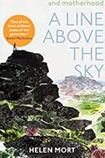
Helen Mort comes to the unwieldy genre of nature writing/place writing/memoir trailing in a dark and intriguing novel, Black Car Burning, and a fine collection of accolades as a poet. That novel, set among young rock-climbers in and around Sheffield in the English Peak District, anticipates her interests in A Line Above the Sky: risk-taking, gender and the allure of climbing, but now complicated by motherhood.
The “new” nature writing, announced by Granta magazine in 2008, remained with few exceptions (all hail Kathleen Jamie) very similar to the old nature writing for some years: white, upper class, given to nostalgia and male. Recently girls have been allowed in, but mostly sad or damaged girls, grief-stricken Helen Macdonald befriending hawks, Amy Liptrot recovering from addiction and counting corncrakes in Orkney, Raynor Winn down and out on the Cornish coast path, Kerri Ní Dochartaigh returning to childhood trauma.
Helen Mort is fit and well, normally disconcerted by new motherhood, reflecting on teenage troubles weathered well enough, hungry to get back out into the hills after the forced hiatuses of childbirth and lockdowns in a way recognisable to those of us whose function depends on outdoor activity. The book is partly about the transgressive nature of competence and strength in a female body in a culture that likes its women scared and fragile and doesn’t tolerate their risk-taking, but from a literary point of view its project is to write the distinctive physicality of rock-climbing, the blend of muscle memory and constant, second-by-second calibration of risk that gets people up cliffs: “You’re following a diagonal fissure in the rhyolite, keeping your feet on either side of it, bridging where you have to. The handholds are good, the footholds slightly precarious . . . You move your left foot up onto something slippy, flinch, regain balance.”
The narrative changes gear, first, second, third person, moves out into the history of women’s rock climbing, back to Mort’s own development as an athlete, back to a here-and-now on the rock, each testing the weight and balance of sentences and images, looking at the literary view.
The book opens with Mort’s “friend, ex-boyfriend and climbing partner” “struggling through the thickness of snow and the thinness of air, climbing steadily towards a cold dawn” in the Himalayas, while the narrator finds herself “doubled up on the examination table of the birthing suite”, embarrassed that years of climbing and fell-running have not prepared her better to endure childbirth. She sucks on Entonox in the birthing pool while he sucks supplemental oxygen on Ama Dablam and, guiltily, she envies him.
Giving birth is often compared to athletic achievement, usually in relation to marathon-running and usually by people who don’t run marathons. (It’s not that hard. You just keep running for longer than usual.) What’s different here is that the equivalence is denied. Labour is not a replacement for mountain climbing. Motherhood is not instead of athletic pleasure. It’s not a fair exchange. “What we seek in climbing,” Mort writes, “is a passionate dance with control . . . you expose yourself to risks that come from somewhere beyond you . . . Climbing gives you . . . just for a while, the tantalising sense of being able to stay one move ahead of death.” Compare that to changing nappies.
Mort finds a guide to climbing while female in the life and biography of Alison Hargreaves, the English climber who died on K2 in 1995, leaving a husband and two young children. Journalists castigated Hargreaves for continuing to climb after having children, despite (because of?) the apparently uncontroversial fatherhood of many male climbers. She had to defend herself repeatedly and there was a note of I-told-you-so, brought-it-on-herself in the coverage of her death when those of male climbers were heroic tragedies. Hargreaves grew up near Mort, though 20 years earlier. They learned to climb on the same rocks, but Hargreaves died in Mort’s childhood and they never met.
“This is a non-consensual partnership. Only one of us is alive, only one of us can defend themselves, speak their desires . . . I was never in her life . . . And yet. There is something comforting in that transparency, in being unseen, being unknown. In chasing her ghost, I become a ghost in my own life.” And this ghosting one’s own life is, as Mort notes, the writer’s position.
It would be easy to think of A Line Above the Sky as a rock-climbing/maternity memoir. That’s not wrong, but the book also sets itself the more interesting task of worrying at the relationship between writing and movement, being as fully embodied as you have to be to stay on, go up, the mountain and simultaneously as fully present in the mind as you have to be to make good sentences, paragraphs, books. Taken either way, it’s strong stuff, satisfying and intriguing to read.













